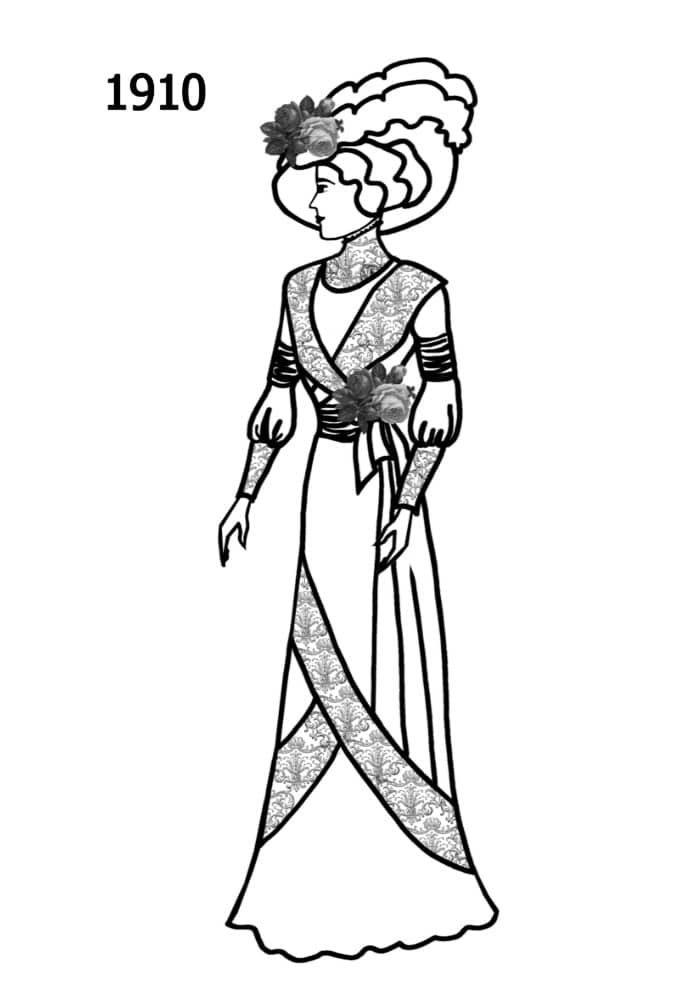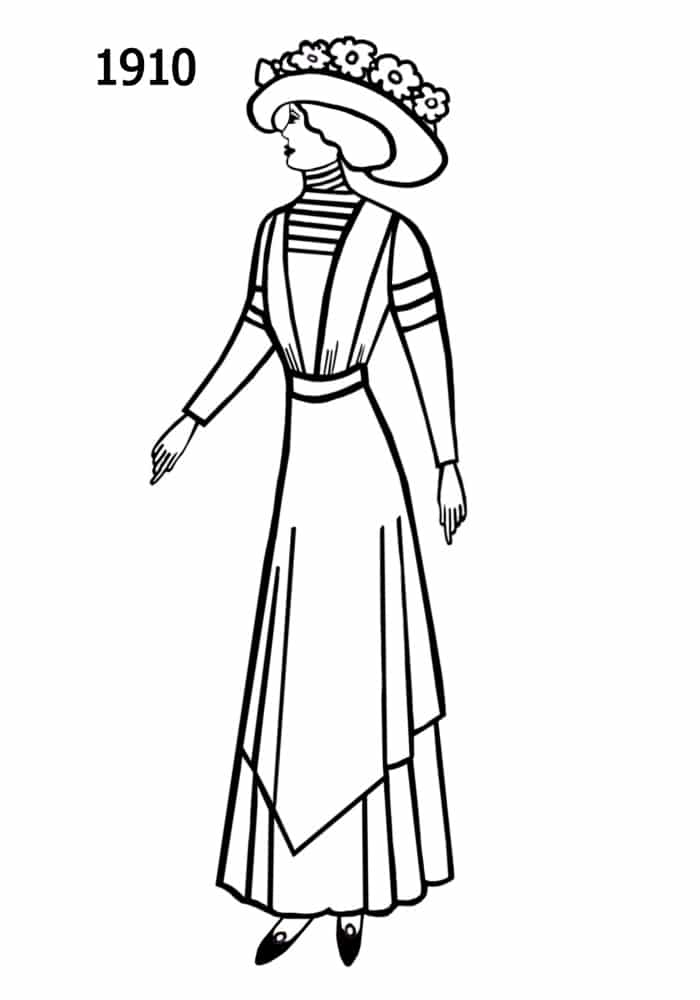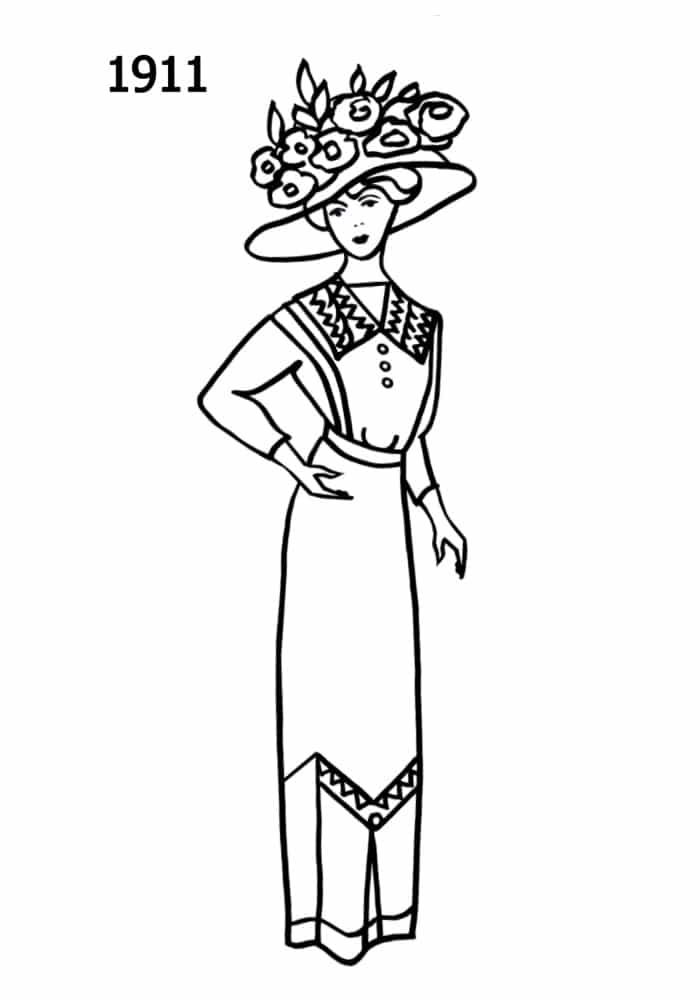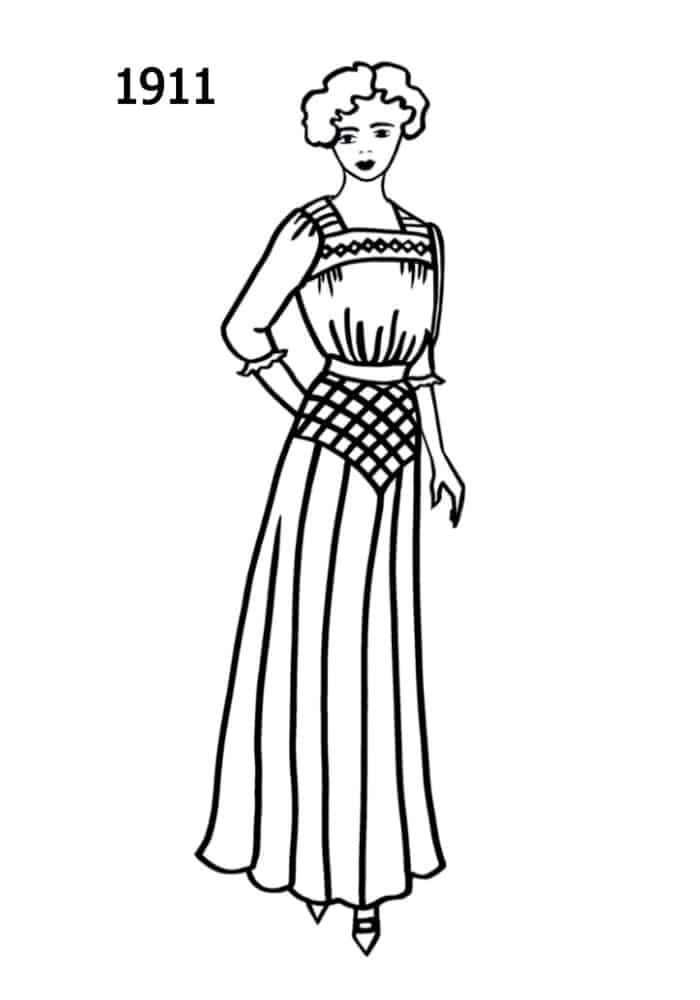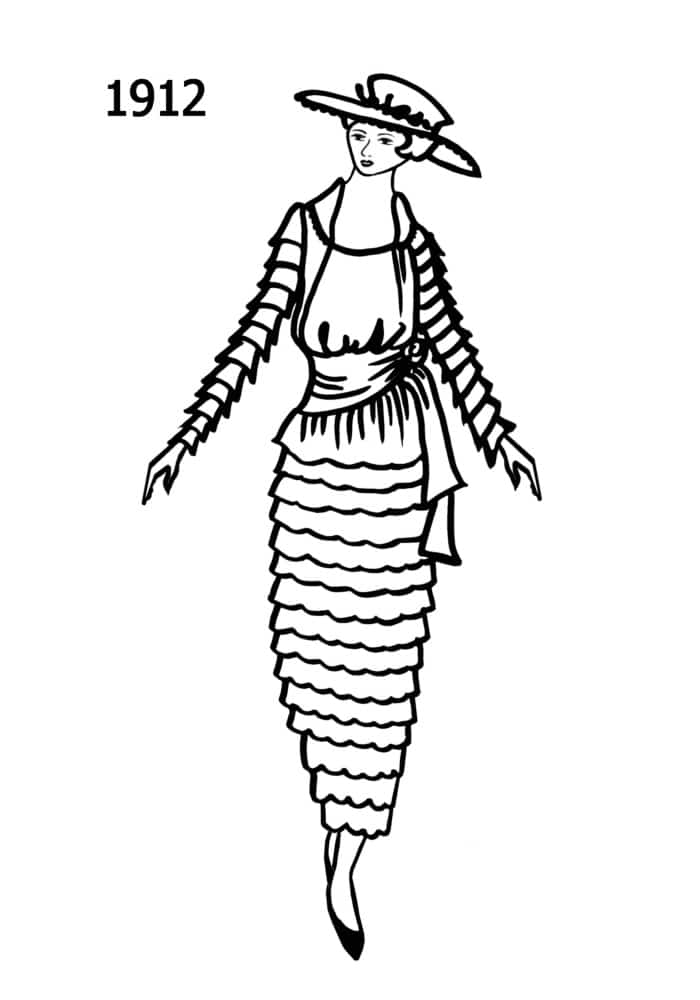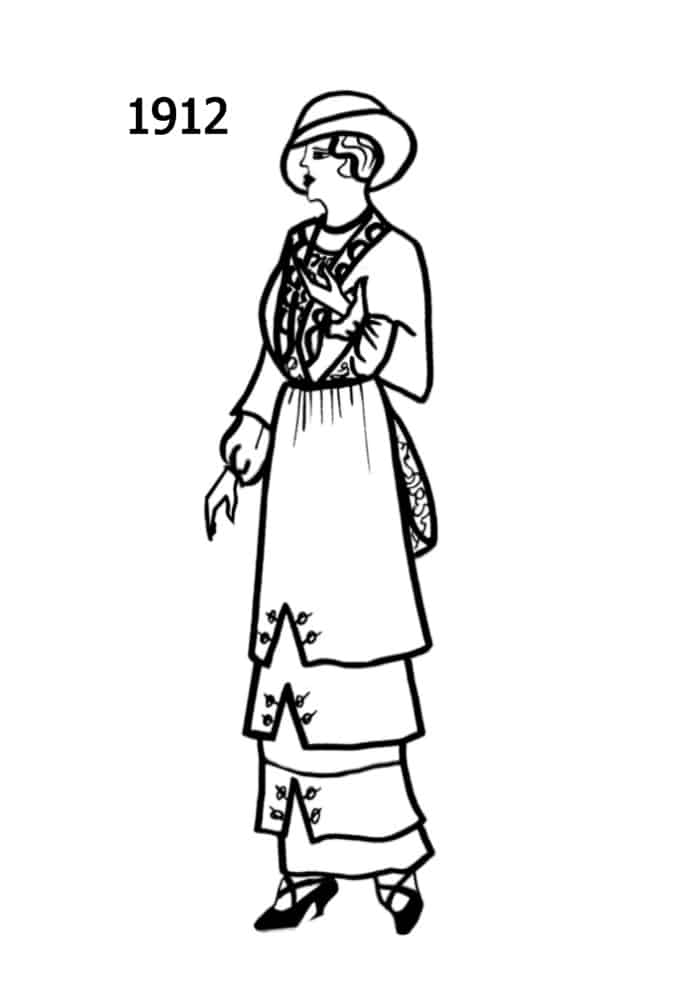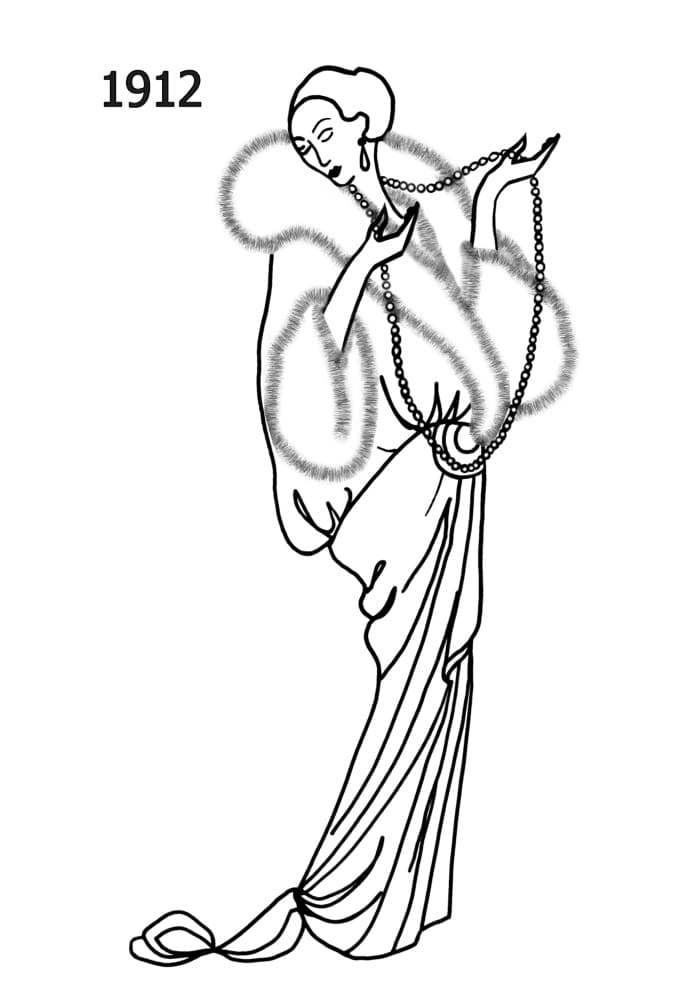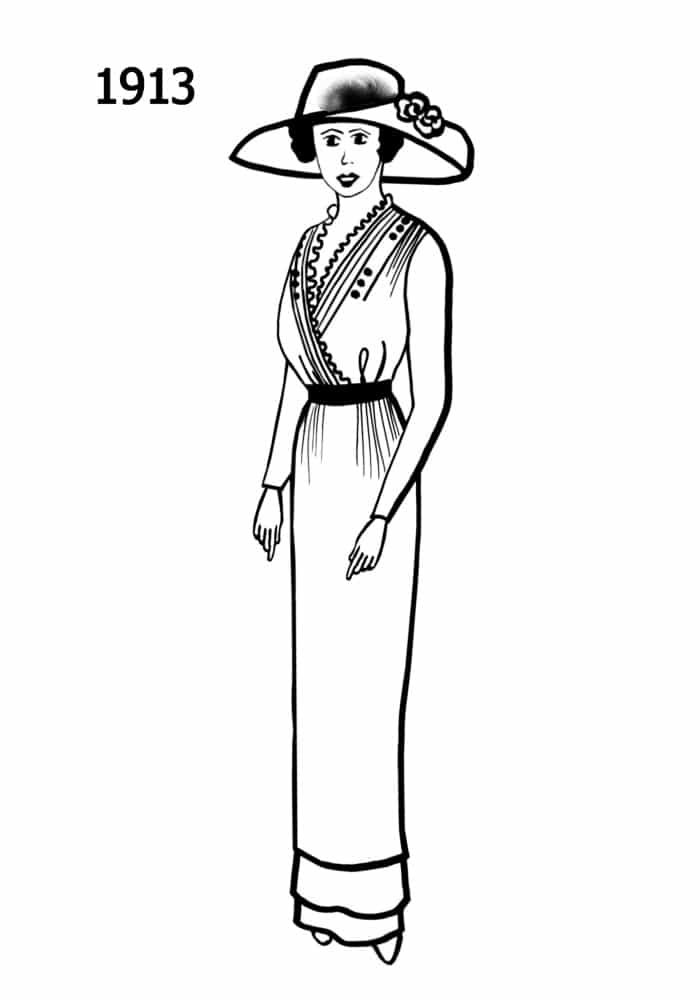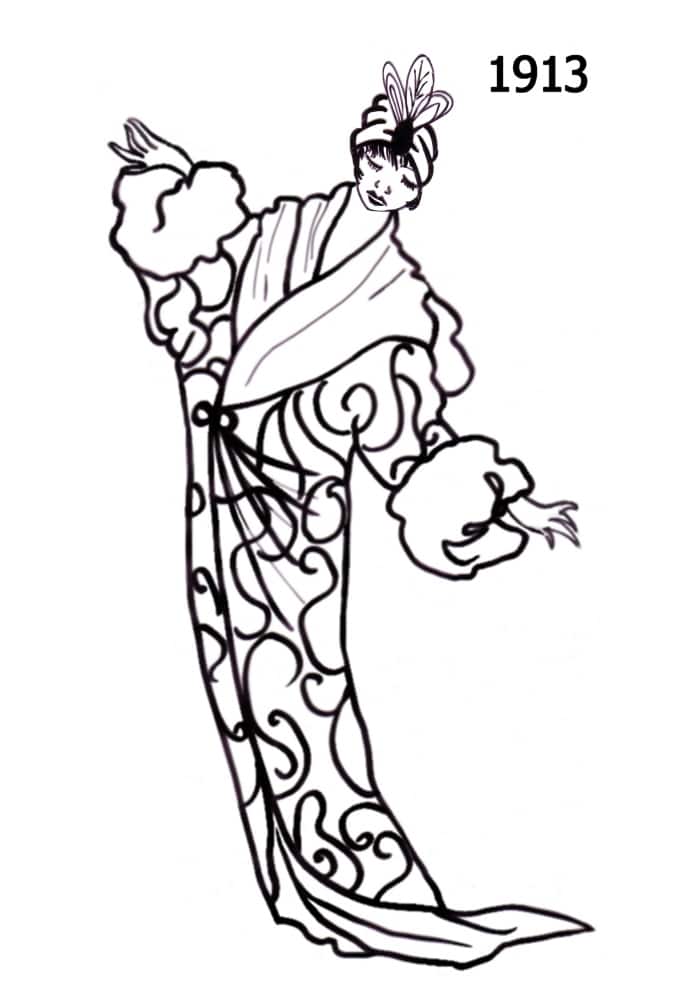By Pauline Weston Thomas for Fashion-Era.com

- Le Journal des Demoiselles
- Titanic Era
- Dresses of 1913 & V Neck Waists of 1914.
- Titanic Era Reprints
- Asian Influence in Edwardian Dress
- Paul Poiret's Directoire Styles
- Poiret's Harem and Lampshade Look 1913
- Poiret's Hobble Skirt
- Craft Artists Inspired by the Asian Culture
- Mariano Fortuny 1871-1949
- Leon Bakst
- Raoul Dufy
- Erté
- 1914-1920 Towards Dress Reform
- Dress Reform 1905 1915
- 1914 Underwear and the First Patented Bra
- Hair
- The Tango Craze
- Clothes Styles During the First World War 1914-1918
- Women and War Work
- National Standard Dress
Le Journal des Demoiselles - Titanic Era 1913 and 1914
The era of the fashion plate as examined here, really came to an end by 1920. By 1899, very few magazines still hand-coloured fashion plates. It survived only in a few old-established magazines like Le Journal des Demoiselles, which had been published from 1833.
My three fashion plates below are from 1913 and 1914 copies of Journal des Demoiselles. The paper is a reasonable ecru tone magazine weight, not any thicker than plates from the Englishwoman's Domestic Magazine or La Mode Illustrée. The natural size is about A4.
Titanic Era
I especially like this era which seems more and more often to be referred to these days as the Titanic era, particularly since the 1990's remake film of the name. I still feel that anything pre-1914 does belong to the mood of the Edwardian era. However, I think it is better to have name for these few years which precede the First World War of 1914-18 than tag them onto the late Edwardians. Early Edwardian fashions are very different from late Edwardian fashions.
One other point is that these early fashions are quite different from the clothes after 1915 which firmly belong in the twentieth century. The time span 1915-1919 with shorter clothes and less structured styling is what most people think of when they refer to this decade as the teens.
Powerful influences in fashion at the time had included the arrival of a fantastic department store in London called Selfridges in 1909, Poiret's interpretation of Russian ballet costumes and a loosening up of standards under the influence of passionate, sexually charged dances such as the tango. Dresses with interesting back and ankle detail suitable to wear to tea dances were all the rage.
The first Le Journal des Demoiselles plate of 1913 is a good example of fashionable tea dance dress of the Titanic era (1912). Note the V-neck which was very novel at the time, along with the Directoire-styled empire line that sits under the bust. The fur trim swathing the dress and the tiered layers are all features of this era. The hair has softened up a little and is more natural looking than circa 1900-1908.
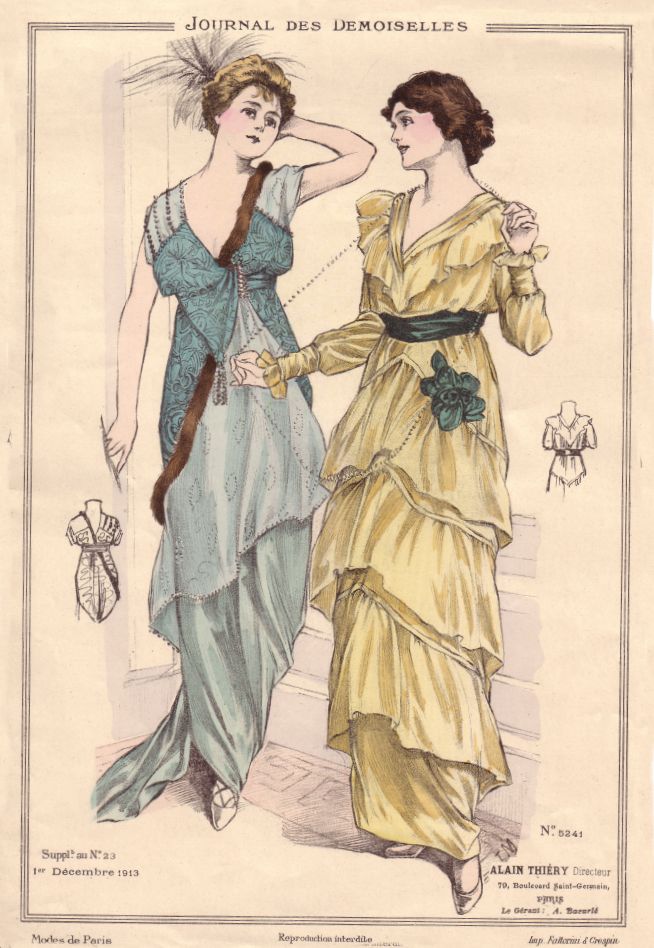
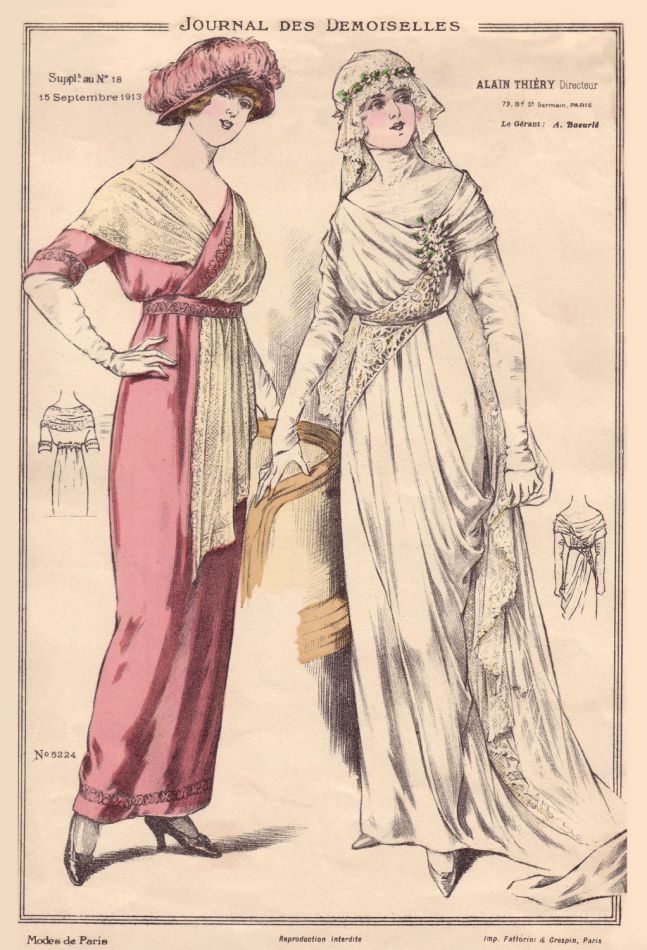
Note the V-neck which was very novel at the time, along with the Directoire styled empire line that sits under the bust.
The fur trim swathing the dress and the tiered layers are all features of this era. The hair has softened up a little and is more natural looking than circa 1900-1908.
The Directoire style of dress and the feathered hat is very reminiscent of fashions of the early 1800s.
This is a 1913 example of bridal dress and the veil style of the era. This style of bridal veil stayed in fashion for about 20 years.
You can see a photo of a similar 1930s wedding dress
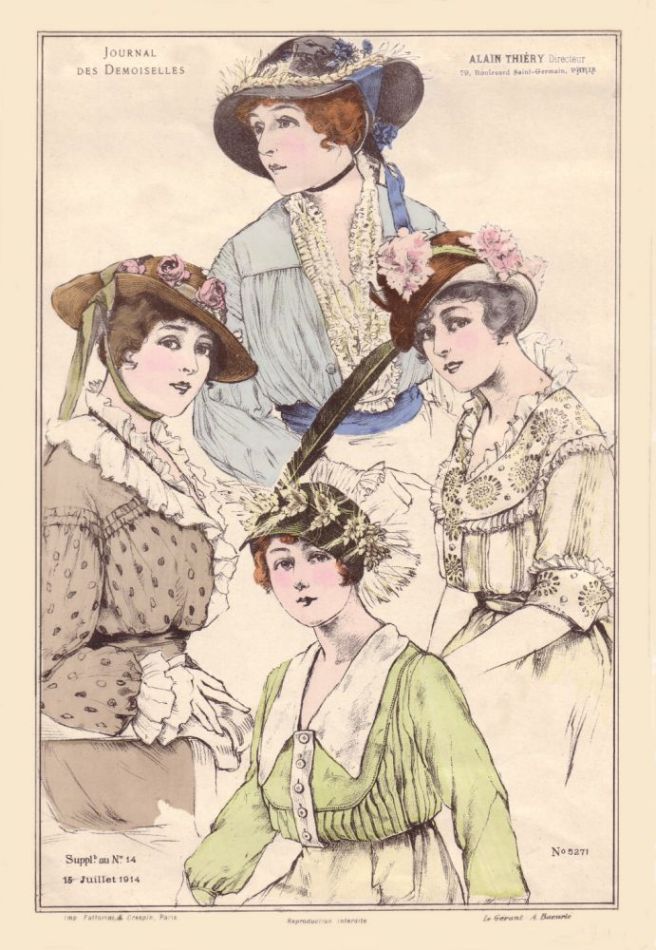
1914 blouses were often called waists. A waist was a very fashionable useful item worn with a skirt. Waists often appeared in catalogue advertisements. In the fashion plate below these ladies wear waists and lovely matching day hats. The look is soft and feminine, before more utilitarian functional clothes of 1914-18. These waists all feature the denounced from the pulpit, V-neck of the era and are worn with attractive matching day hats.
If you like this era and are interested in these fashions you can collect the fashion plates in a random manner as you see them in antique shops or online.
If you are looking for an instant set and like a more pristine article you may prefer to buy reprints such as these below from websites.
1910s Fashion Plate Reprints Titanic Era
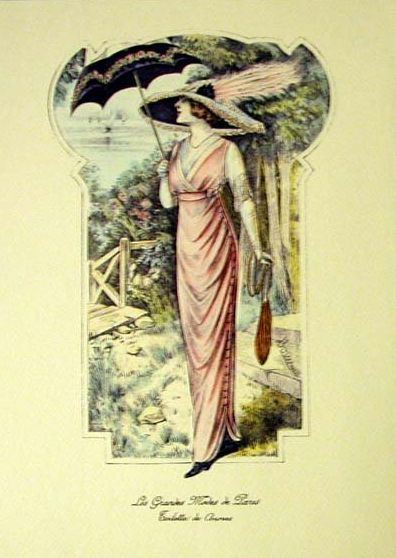
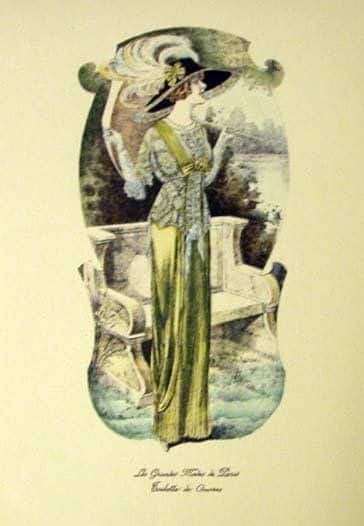
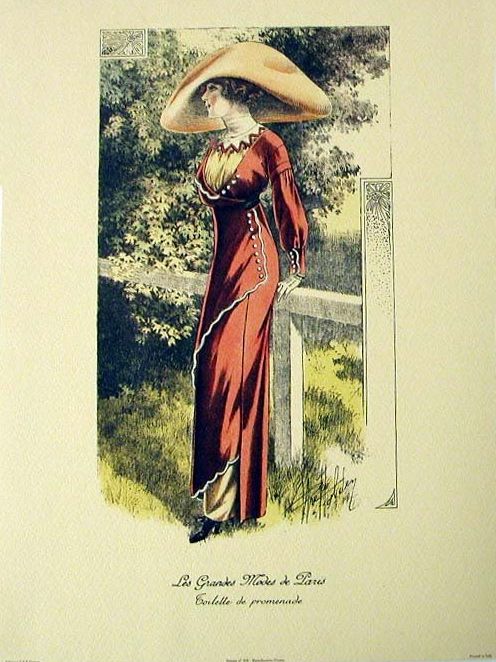

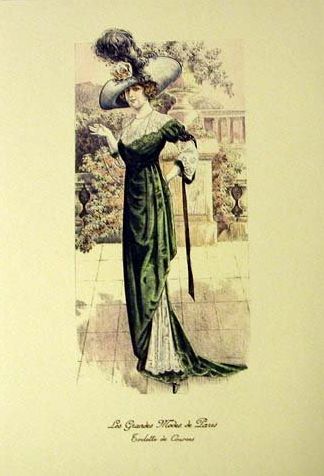
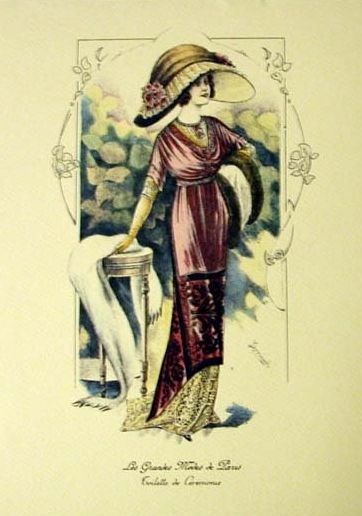
1910s Fashion Silhouettes 1910 to 1913
I've studied costume drawings and fashion plates of the fashion history period 1910 and 1913.
Then I have drawn out these simple line drawings and finally enhanced aspects such as fur trims, and patterns with computer software.
The drawings on this page show some of the silhouette body shape outline between 1910 and 1913 which is loosely used as a basis for Titanic style reproduction pieces. The Titanic sank April 15 1912, but many of the line drawings here would be suitable for purposes of costuming.
Each thumbnail enlarges to produce an A4 print and is suitable for colouring in and producing timeline scenes, collage foundation guides or guidelines for amateur dramatics.
Like many costume enthusiasts, on occasions, a basic simple line image of a specific year in fashion history enable me to complete a project. These images should give you a clear understanding of the changing lines and variety of fashion silhouettes within a few years.
Asian Influnece in Edwardian Dress
Paul Poiret's Directoire Styles
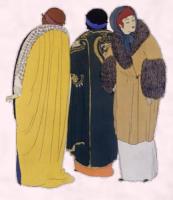
Paul Poiret trained at the House of Worth and Doucet and set up on his own in 1903. He made straight tube like sheath dresses in 1908. The styles were known as Directoire as they were similar to fashions of the early 1800s.
The columnar style he introduced meant that women had to abandon their S-bend corsets and wear a longer straighter corset that almost reached the knees to achieve his early look. Later he encouraged women to free themselves from corsetry and adopt the bra.
Poiret was very sensitive to the mood of society and to trends among painters and designers. He was very influenced by Asian culture in Leon Bakst's Ballets Russes costume designs.
Over the years Poiret worked with several artists who drew fashion drawings and textile print designs for him. The artists portraying Asian culture included Paul Iribe (1908), Georges Lepape, Raoul Dufy and Erté. Poiret's influence on fashion illustration and fashion presentation was enormous and attractive prints by these artists are still used in interiors to set a mood.
Poiret's Harem and Lampshade Look 1913
Poiret loved bright colour and introduced brilliant hues whilst the sweet pea colors of the Edwardian era were still very fashionable. He had been influenced by the Ballets Russes and in 1913 he produced exotic designs based on Asian culture harem pants. His lampshade tunic and turbans were all in vibrant glowing shimmering colours, with beaded embellishment.
To complete the outfits there were exotic Eastern inspired jewelled slippers which drew together Asian culture in the outfit.
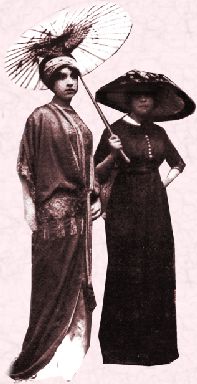
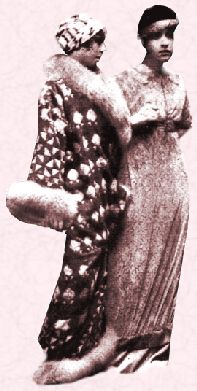
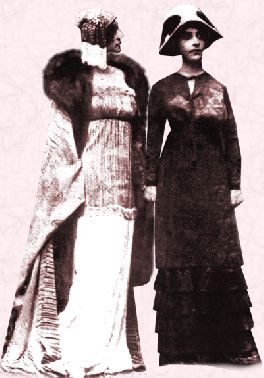
Above: Gowns inspired by the asian culture complete with Asian culture parasol and coolie lampshade-inspired hat. Cloche hats, fur edgings on coats and long columnar dresses worn by Poiret's models.
Fur was a symbol of Asian culture and appeared on all sorts of garments from outerwear to lingerie as an edging trim.
Poiret's Hobble Skirt
Having liberated women by putting them into pants Poiret then sought to design extremes and became famous for designing a hobble skirt which drew the legs closely together as it was so narrow. To increase the hobble effect women needed to wear a 'fetter', a kind of bondage belt that held the ankles together and prevented the wearer from making any movements other than small steps in imitation of Geisha girls.
The hobble skirt was probably Poiret's last real success as new designers like Chanel and Lanvin opened up Fashion Houses and began to design unrestrictive clothes that women really felt comfortable wearing.
At the same time the V neck for daywear was introduced and it was thought so shocking that it was denounced from the pulpit.
Ragtime
The forerunner of jazz was ragtime music and it started as early as the 1900s, sweeping Europe in the early 1910s. Ragtime was the basis of many new dance crazes. Animal movement was frequently imitated and famous dances included the Grizzly Bear, the Turkey Trot and the Bunny Hog. These energetic dances were best performed in fitting dresses with long side slits that allowed for dramatic movements.
This type of dancing required a new closeness and a certain intimacy between partners, so it was inevitably frowned upon by less liberal people still locked in Victorian mores and customs.
Craft Artists Inspired by the Asian Culture
Mariano Fortuny 1871-1949
Mariano Fortuny 1871-1949 was a Spanish painter and inventor. He designed scarves that paid homage to ancient Greece and Crete. Later he experimented with pleating fabrics so that they draped over the female body. A version of his Delphos Gown patented in 1909 was frequently worn by the dancer Isadora Duncan. The minutely pleated silk was a secret process and the glorious colours were produced using vegetable dyes, a refreshing change from the crude aniline dyes that had been recently used.
Left - A Fortuny pleated gown worn by Lilian Gish.
His clothes had batwing sleeves and were silk and silk velvet with his original hand-printed stencil designs. Venetian glass beads weighed the hems.
Leon Bakst
Leon Bakst designed and made flamboyant exotic colourful costumes for Diaghilev's Ballets Russes. He used colour in an Asian way, using bold hues and sharp contrasts with highlights of embroidery and heavy appliqué. The idea behind the clothes was that women would look like harem slaves.
To emphasize this he put women in turbans and harem pants. Much of his work showed Asian culture influence.
Raoul Dufy
Raoul Dufy was one of the artists that founded the Fauvist movement. Dufy made fabric prints and worked on interesting dyeing techniques to enhance Paul Poiret's work in fashion. Later Dufy worked for a French textile firm where he designed dramatic prints for silks and brocades.
Today many of us remember him for his wonderful light-infused paintings of the south of France.
Erté
Erté was a stage costume designer who produced exotic, theatrical, elongated clothes. He designed for Poiret, did art covers for Harpers Bazaar, drew ballet costumes for Diaghilev, and designed sets and costumes for theatres in Paris and New York. Much of his work also showed Asian cultural influence.
1914-1920 Towards Dress Reform
Dress Reform 1905-1915
In fashion history terms time never stands still. In the Edwardian era, new influences and changing society in a young century began to challenge the stiff formality that prevailed.
In the years between 1905 and 1918 clothing styles emerged that were evolutionary in bridging the gap between the rigid formality of the Edwardian styles and the ultimate changes that led to the knee high dresses of 1926.
Asian culture influences have been shown in fashion history in women's dress in other eras such as in the 1800s, the mid-1920s and later in the 1970s and 1990s. It was in total contrast to the prevailing mood of dreamy pastels favored by high society when hot tropical colors and a new silhouette was introduced.
In 1920s fashion history, the initial break with the traditional styles stemmed from the inspiration drawn from the Aesthetic and Rational Dress Reform Movements of the late 19th century. Exciting theatrical costume designs which broke the rules also paved the way for more relaxed dressing. This was all fast forwarded during the war years and led to the major changes in construction of clothes and undergarments for the remainder of the century.
This era from 1905 to 1915 was particularly important in eroding attitudes to dress which had been stuck in the rigidity of the Victorian era for too long. Barriers broken in this period laid the foundations for the more relaxed clothes of the 1920s.
1914 Underwear and the First Patented Bra
The fashions of the era needed a new approach to under foundations. The first bra was patented in 1914 by Mary Jacobs an American. It is not thought to be the first bra ever, but it is the patented record that gives her the credit. Cretan women had the idea long before and various BBs or Bust Bodices or improvers had been around in Britain and France since the Edwardian era and exist today in costume collections.
Several designers including Paul Poiret, Lucille and Vionnet all say they invented the bra as correct underwear for their new dress innovations and admonished clients to abandon their corsets. We will never truly know. What is certain is that a bodice designed separately from the corset had become usual wear by 1905 and Mary Jacobs had the intelligence to patent a design for a bra.
1910s Hair
Many women had begun to cut their hair when doing war work for practical reasons. A compromise between long and short tresses was 'Curtain' hair and was favored by the genteel. Worn with a band it could be dressed more prettily with a feather at night. Colouring hair with Henna was popular as it was less risky than using the unreliable chemical dyes of the time, and it looked well with the Asian culture influences.
The Tango Craze

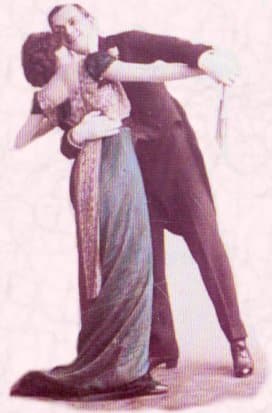
Dancing was very popular and had a great influence on 1920s fashion.
A famous American dancing couple called the Castles helped spread the new dance crazes and magazines showed the steps of the latest dance, with a graphic for each new movement. People practiced at home using the magazines as guides.
When troops were at home on rest leave during the war dancing gained popularity and by 1919 many dance halls had opened.
The Tango dances made their mark on fashion history.
Clothes Styles During the First World War 1914-1918
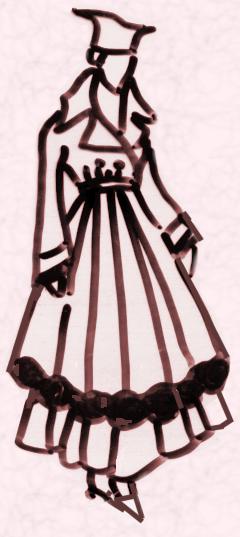
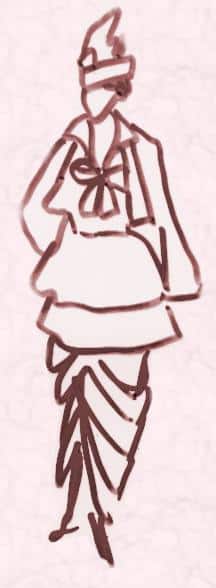
Above: Sketches of a restrictive hobble dress and the slightly later more liberating double skirted mid calf dress of 1916.
All the changes that were forced on a rigid society were a direct result of the war. Women stopped wearing jewelry and lavish clothes. Dress rules for both sexes were relaxed in theatres and other venues. Women began to take part in voluntary philanthropic work which ultimately broadened their horizons and changed their outlook forever.
As women mixed with other classes social barriers were eroded and the relaxed dress rules meant that they all began to look similar.
The effect of war on fashion styles was that military braiding, belts with buckles and shorter skirts were seen everywhere. Fashion history shows that clothes got shorter during the First World War out of practical necessity.
In 1915 the hemline rose dramatically to mid-calf, a height never before reached. Waistlines were still quite high following the Directoire style. But the double layered skirts as if to compensate for the length had a fuller top skirt often like a mini crinoline, worn over a slimmer under skirt also made of the top skirt fabric. Such garments were often fur trimmed.
Bright colours faded from sight and only sober colours were worn as the war dragged on. Everyone was affected by the death of a loved one and so subdued dresses were simply a matter of good taste showing patriotism. By 1918 the fuller top skirt had gone and the calf length long skirt remained.
Women and War Work
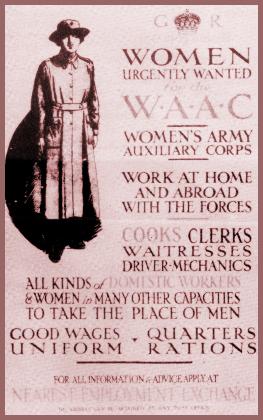
Many women gave up domestic service work and worked. They drove trams and collected the fares, did administrative tasks, lamp lighting, postal work, worked as chimney sweeps and nursed.
Women did farm work working as Land Girls. They also served in the WAAC, the Navy, the Red Cross and the Police began admitting women.
By 1917 over 700,000 women were employed to make munitions, wearing a working uniform of blouse and peg top trousers accessorised by scarves and fashion items.
As a recognition of their efforts it was later replaced by a uniform of khaki overalls and caps.
When the war ended the same women simply did not want to return to being maids for other people. They had gained a new freedom working outside of homes with set hours and a comradeship and respect that they relished.
Amazingly after all their efforts only the jobs of bus conductresses remained open to them, but the barriers were broken and soon a wider choice of options became usual.
National Standard Dress
In 1918 an attempt was made to introduce a utility garment as a National Standard Dress. It had no hooks and eyes but metal buckles and was supposed to be an all-purpose garment that could be a dinner gown, day gown or nightdress. It never took off!
Lessons learned from this were used in the 1939-45 war when women were given ration coupons but had an element of choice in what they wore.
